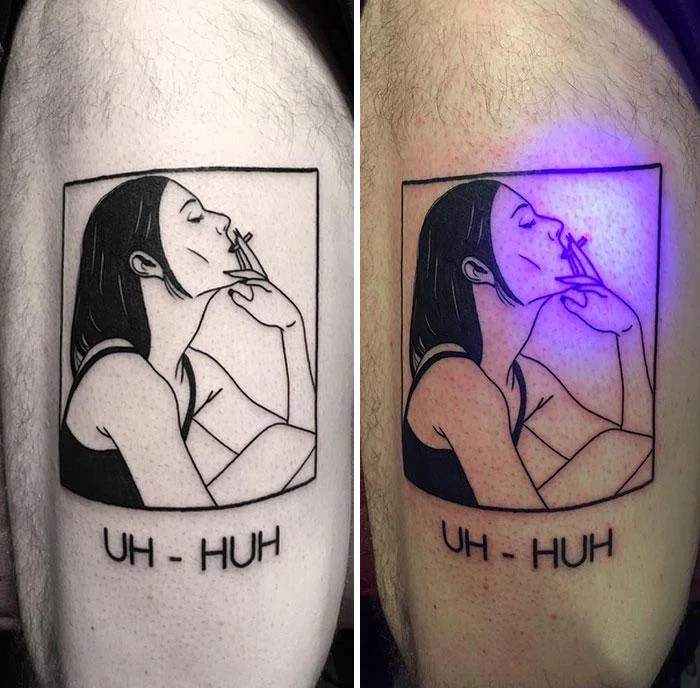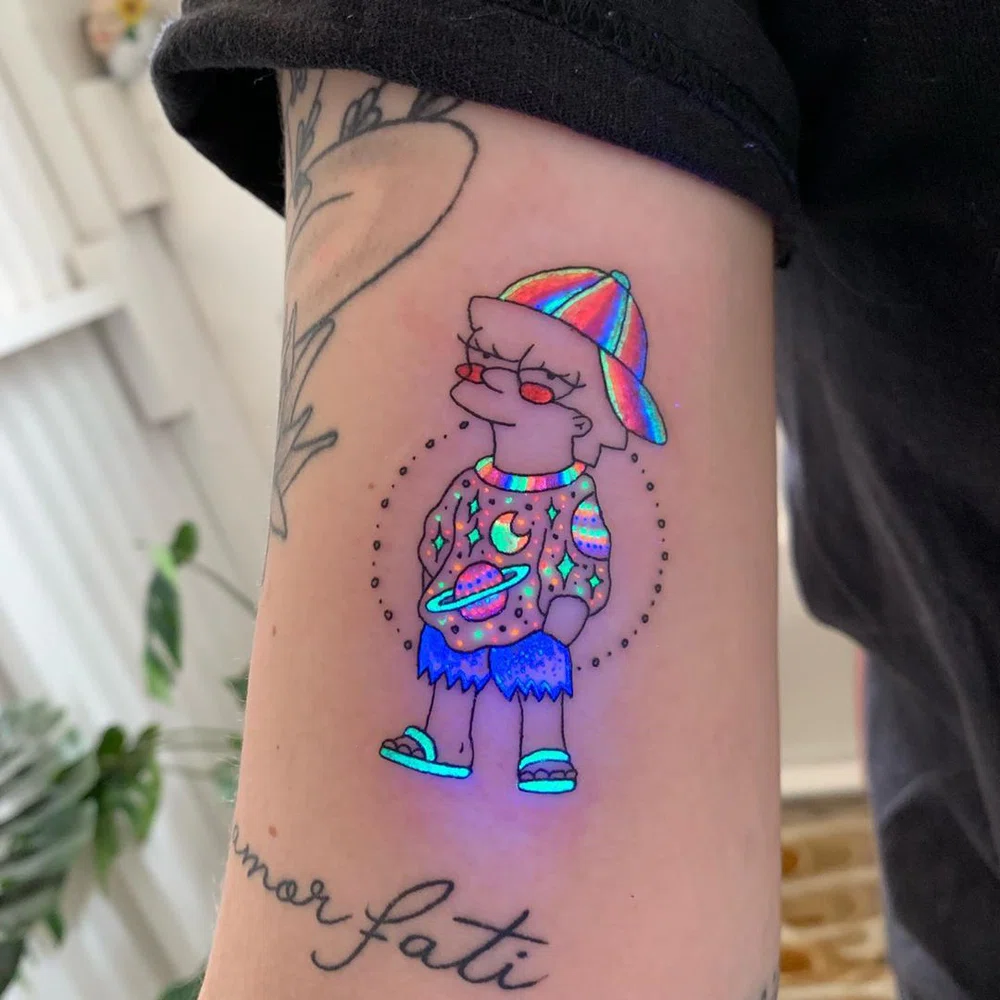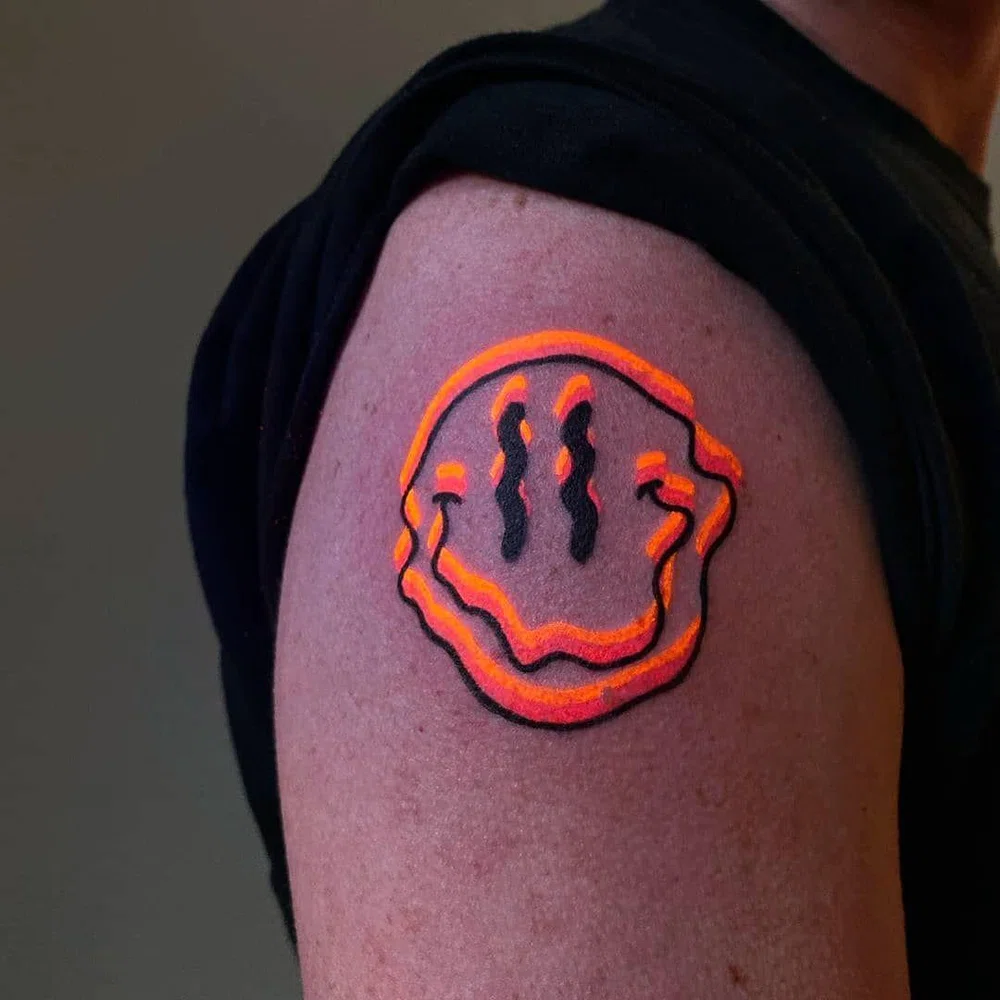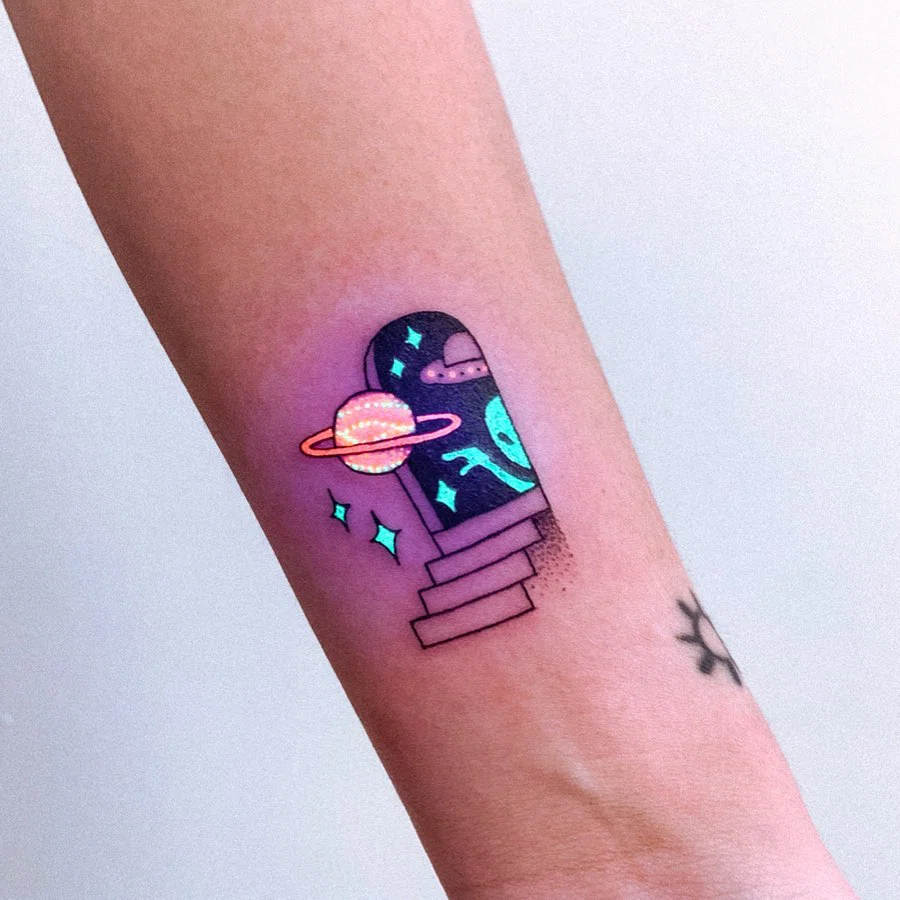Invisible tattoos, a safe trend?
Everything you need to know about invisible ink
24 May 2024
Imagine you had to tattoo a client who, instead of proudly showing it, prefers to make it invisible and hide it!
Did you know that some inks can only be seen in UV light?
This is a quite new type of tattoo, which has recently become popular. It consists in using a particular UV ink.
This ink makes the tattoo invisible in daylight, incandescent light and LED; in fact, they are totally imperceptible!
Do you want to learn more? Keep reading.
What are UV inks?

These inks are made in a particular way to only be detected when exposed to ultraviolet or black light, thus obtaining a bright neon effect.
The result is certainly eye-catching, that’s why many people choose it. They are too versatile and fun to watch. But let's get down to brass tacks… How is this ink made?
UV inks are based on vegetal substances, metals, thickener and, most importantly, phosphorus. This last one is responsible for the emanating light effect, as it’s a photo-reactive element that concentrates energy to then radiate it as light.
Once healed and in regular lightning conditions, the aspect of these tattoos covers from translucent to whitish with a hint of yellow. They can also be recognized by the skin relief. However, they are really difficult to notice.
Unlike regular inks, this one is thicker and ends up completely absorbed by the skin after a while.
The good thing about these inks is that they can be used either as a base, making it fully invisible; or as a complement, by merging different types of inks. And it can be applied both underneath or on other inks.
So, it could be used either to a conventional tattoo glow or to have a brand new fluorescent tattoo.
How can you tattoo if the ink is invisible?

Technically, you can actually see it. Although, the truth is that, with translucent UV inks, the whole process differs from using conventional inks. Either way, some steps remain the same, as it happens with the stencil.
As in any other tattoo, you’ll use a stencil to transfer the design into your client’s body; but, once tattooed, those who have already worked with this ink can get good results out of practicing with incandescent lights.
Anyway, there are other artists who prefer to work with black lights to see how the ink is inserted into the skin and avoid any inconveniences.
Differences between UV inks and fluorescent inks
UV inks are transparent, and usually respond as blue to black light. Plus, you can find difficulties when tattooing because of its imperceptible aspect.
Fluorescent inks, even though they look alike, aren’t the same. They are pigmented so you can detect them in the tattoo, and they are more visible.
Besides, they don’t need black light to glow because they can enhance colors by themselves.
Are invisible tattoos safe?

As striking and attractive as they look, we can’t ignore that there are some uncertainties about how they can affect our health.
The main problem lies with the fact that these inks are based on heavy substances such as metals, or even plastic derivatives. But the most worrying component is phosphorus.
The effect of these inks can cause intense inflammation, in comparison to the regular ones. In addition, phosphorus and the rest of its components, chemical or vegetal, can be potential allergens.
And most importantly, these inks are yet to be legally approved for human use. UV inks can’t be considered as totally safe because of the amount of skin irritations and other effects recorded among its wearers.
You can find some phosphorus-free inks to lower the risk of allergic reactions though. However, they only react to ultraviolet light and won’t glow in the dark.
Can this be a serious risk to health? Not necessarily but we do recommend that before using them, you get well informed and talk to several tattooing studios and ink brands to clear all doubts. And of course, always consult a healthcare professional.
Because of its novelty in the market and the little number of usages compared to the conventional inks, sometimes it’s hard to learn all about the pros and cons and their effects on our health. That’s why we encourage you to search for more than just one source before trying them with your clients.
Can you remove a UV ink tattoo?

This is another concern when it comes to these types of tattoos… In case of regret, allergic reactions or any other inconvenience, can they be removed with laser or other methods?
The answer is yes, they can. And like in any other tattoo, laser detects the pigment and destroys it in tiny particles to then be expelled by the body; as so it it with regular inks.
Still and all, as we’re talking about pretty light inks, it’s actually more complicated for the laser to detect them, as it happens with any conventional light ink. So, a UV tattoo removal procedure can be more expensive and lengthy than a regular one for darker inks.
Laser removal procedures usually last months until they can eliminate the tattoo, and sometimes it can’t even erase it completely. It’s essential to wait for the recommended time in between sessions, normally, at least three weeks.
Otherwise, there’s a risk of overly altering the skin. Besides, even though the pain threshold is rather personal, part of the pain or discomfort in each laser application has nothing to do with that of a needle and in fact, it usually occurs to a greater or lesser degree.
This is due to the invasive skin damage. That’s why it’s crucial to pay much attention to the time needed before removing it, especially in these types of tattoos that are harder to detect by the laser.
This way, you can guarantee its healing and give the skin enough time to recover and avoid future risks or complications such as keloids, blisters, and so on.
Likewise, if someone wants to remove it right away, it’s probably because they didn't like it in the first place. For that, it’s important to first be sure about getting that kind of tattoo. If you experience a hesitant client, the best for them is to have a second thought.
All the same, if as an artist you are feeling doubtful or unsure, you can always decide not to do it and wait for having enough information to make it easy for your and your client.
¿How to take care of an invisible tattoo?

Aftercare is similar except for the need of being more cautious about sun exposure since UV lights can cause pigmentation damage and affect its durability over time. Plus, they can get stained and provoke undesired effects on the skin.
On the other hand, the healing process is way more complicated and it usually takes longer than other tattoos. For this reason, as mentioned before, it is essential to think twice and get well informed before getting it and then take good care of it to avoid allergic reactions.
In case that happens, remember to consult a doctor urgently. Don’t forget that hydration is also important, so apply creams, balms or protective ointments to take care of it as a daily routine.
UV tattoos, yes or not?
Invisible tattoos are an original and eye-catching style. However, there’s a lot of controversy in their making, as many inks aren’t homologated yet and this may involve subsequent complications.
Allergic reactions are quite normal in these kinds of tattoos, and sometimes people don’t even take enough precautions. That’s why we invite you and your client to talk to a dermatologist before and after getting a tattoo of this sort.
This doesn’t mean that all people react in the same way. In fact, many people wear this kind of tattoo, and they have no problems whatsoever.
You just need to be cautious regarding any possible inconvenience and be well-informed to do so.
And you, did you know about these inks?
Remember that taking care of the skin and taking necessary precautions is essential for tattooing. And we're not just referring to the materials you choose, but also to the techniques you apply.
Something you learn in depth within our online tattoo courses, thanks to the experience of qualified professionals.